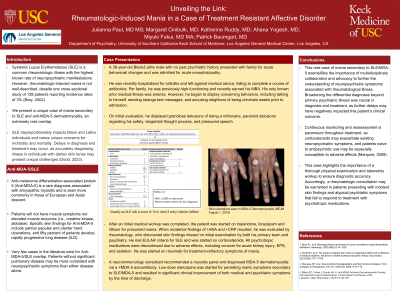Transplant Psychiatry and C-L Subspecialties
(221) Unveiling the Link: Rheumatologic-Induced Mania in a Case of Treatment Resistant Affective Disorder


Julianna V. Paul, MD, MS (she/her/hers)
Psychiatry Resident
USC+LAG Psychiatry
Los Angeles, California
Margaret Cinibulk, M.D.
Psychiatry Resident
USC+LAG Psychiatry
Los Angeles, California- KR
Katherine Ruddy, MD
Rheumatology Fellow
USC
Los Angeles, California - AY
Ahana Yogesh, MD
PGY4 Resident
LAGMC+USC
Los Angeles, California 
Miyuki Fukui, MD, MA (she/her/hers)
Clinical Assistant Professor of Psychiatry and the Behavioral Sciences
Keck School of Medicine of the University of Southern California
Los Angeles, California
Patrick Baumgart, MD
Assistant Clinical Professor of Psychiatry and the Behavioral Sciences
University of Southern California
Los Angeles, California
Presenting Author(s)
Co-Author(s)
Introduction:
Systemic Lupus Erythematosus (SLE) is a common rheumatologic illness with the highest known rate of neuropsychiatric manifestations. However, rheumatologic-induced mania is not well-described, despite one cross-sectional study of 128 patients reporting incidence rates of 3% (Brey, 2002). We present a unique case of mania secondary to SLE and anti-MDA-5 dermatomyositis, an extremely rare overlap. We discuss the importance of educating clinicians about dermatological manifestations of illness in individuals with darker skin tones. A 38 year-old Black/Latinx male with no past psychiatric history presented with family for acute behavioral changes and was admitted for acute encephalopathy. He was recently hospitalized for cellulitis and left against medical advice, failing to complete a course of antibiotics. Per family, he was previously high-functioning and recently earned his MBA. His only known prior medical illness was anemia. However, he began to display concerning behaviors, including talking to himself, sending strange text messages, and accusing neighbors of being criminals weeks prior to admission. On initial evaluation, he displayed grandiose delusions of being a millionaire, paranoid delusions regarding his safety, tangential thought process, and pressured speech. After an initial medical workup was completed, the patient was started on risperidone, lorazepam and lithium for presumed mania. When incidental findings of +ANA and +CRP resulted, he was evaluated by rheumatology, who discovered skin findings missed on initial examination. He met EULAR criteria for SLE and was started on corticosteroids. All psychotropic medications were discontinued due to adverse effects, including concern for acute kidney injury, EPS, and sedation. He was started on rituximab for treatment-refractory symptoms of mania. A neuroimmunology consultant recommended a myositis panel and diagnosed MDA-5 dermatomyositis via a +MDA-5 autoantibody. Low-dose olanzapine was started for persisting manic symptoms secondary to SLE/MDA-5 and resulted in significant clinical improvement of both medical and psychiatric symptoms by the time of discharge. Conclusion/Implications: This rare case of mania secondary to SLE/MDA-5 exemplifies the importance of multidisciplinary collaboration to further the understanding of neuropsychiatric symptoms associated with rheumatological illness. Broadening the differential diagnoses beyond primary psychiatric illness was crucial in diagnosis and treatment, as further delays may have negatively impacted this patient’s clinical outcome. Continuous monitoring and reassessment is paramount throughout treatment, as corticosteroids may exacerbate existing neuropsychiatric symptoms, and patients naive to antipsychotic use may be especially susceptible to adverse effects (Marques, 2009). This case also highlights the importance of a thorough physical examination and laboratory workup, as symptoms may go unrecognized in patients with darker skin tones (Dodd, 2023). Accordingly, a rheumatologic consultation may be warranted in patients presenting with indolent skin findings and atypical psychiatric symptoms that fail to respond to treatment with psychotropic medications. References Brey RL, et al. Neuropsychiatric syndromes in lupus: prevalence using standardized definitions. Neurology. 2002;58(8):1214–1220 Dodd RV, et al. The impact of patient skin colour on diagnostic ability and confidence of medical students. Advances in health sciences education: theory and practice. 2023;28(4):1171–1189 Marques AH, et al. Glucocorticoid dysregulations and their clinical correlates. From receptors to therapeutics. Ann N Y Acad Sci. 2009;1179:1-18
Case:
Presentation Eligibility: Not previously published or presented
Diversity, Equity, and Inclusion: SLE disproportionately impacts Black and Latinx individuals and raises unique concerns for morbidity and mortality. Delays in diagnosis and treatment may occur, as accurately diagnosing illness in individuals with darker skin tones may present unique challenges (Dodd, 2023). Such patients may also have elevated rates of misdiagnosed psychiatric illness. This case highlights a rare presentation of medical and psychiatric symptoms of SLE/MDA-5 in a Black/Latinx individual. The importance of advocacy and collaboration among specialties to deliver quality care are highlighted throughout the patient’s treatment. Our co-authors represent various ethnic and cultural backgrounds and comprise longitudinal levels of training.

